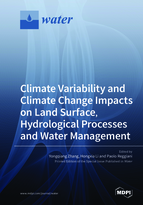Climate Variability and Climate Change Impacts on Land Surface, Hydrological Processes and Water Management
A special issue of Water (ISSN 2073-4441). This special issue belongs to the section "Hydrology".
Deadline for manuscript submissions: closed (31 March 2019) | Viewed by 140075
Special Issue Editors
Interests: remote sensing; hydrology; climate change; evapotranspiration; runoff; predictions; catchment
Special Issues, Collections and Topics in MDPI journals
Interests: hydrology; climate change; evapotranspiration; runoff forecast
Interests: water resources management and forecasting; forecasting uncertainty; catchment hydrology; climate change impact analysis; floods; drought; Bayesian analysis
Special Issues, Collections and Topics in MDPI journals
Special Issue Information
Dear Colleagues,
It is well recognised that the Earth is experiencing dramatic climate variability and climate change, because of global warming caused by human being over the last 60 years. This is strongly influencing hydrological processes, from catchment to regional and to global scales. As a result, each country needs to establish efficient water management strategies to cope with and adapt to these changes. To better understand on the mechanism and responses to the climate variability and climate change, it is crucial to have multidisciplinary studies that involve hydrology, meteorology, remote sensing, ecology, engineering, agriculture, etc.
We invite original research articles that contribute to the continuing efforts of understanding hydrological processes and to engage in more efficient water management strategies in changing environment at a scale from catchment, to region and to globe. We are particularly interested in following topics, but this Special Issue is not limited to only these topics:
- Detecting trends and variation of hydrological variables, such as runoff, actual evapotranspiration and soil moisture;
- Separating climate change and land use change impacts on water balance components;
- Measuring or estimating hydrological variables, such as precipitation, evapotranspiration and soil moisture in data-sparse regions;
- Predicting catchment and regional water availability in a changing climate;
- Detecting eco-hydrological response to climate variability and climate change;
- Water management strategies under climate variability and climate change;
- Human activities (forestation, deforestation, agricultural practice, mining, etc.) influencing water availability;
- Engineering interventions, such as damming, to adapt climate variability and climate change
Dr. Yongqiang Zhang
Dr. Hongxia Li
Prof. Paolo Reggiani
Guest Editors
Manuscript Submission Information
Manuscripts should be submitted online at www.mdpi.com by registering and logging in to this website. Once you are registered, click here to go to the submission form. Manuscripts can be submitted until the deadline. All submissions that pass pre-check are peer-reviewed. Accepted papers will be published continuously in the journal (as soon as accepted) and will be listed together on the special issue website. Research articles, review articles as well as short communications are invited. For planned papers, a title and short abstract (about 100 words) can be sent to the Editorial Office for announcement on this website.
Submitted manuscripts should not have been published previously, nor be under consideration for publication elsewhere (except conference proceedings papers). All manuscripts are thoroughly refereed through a single-blind peer-review process. A guide for authors and other relevant information for submission of manuscripts is available on the Instructions for Authors page. Water is an international peer-reviewed open access semimonthly journal published by MDPI.
Please visit the Instructions for Authors page before submitting a manuscript. The Article Processing Charge (APC) for publication in this open access journal is 2600 CHF (Swiss Francs). Submitted papers should be well formatted and use good English. Authors may use MDPI's English editing service prior to publication or during author revisions.
Keywords
- Climate change
- Climate variability
- Streamflow
- Evapotranspiration
- Water management
- Catchment
- Remote sensing
- Hydrological change
- Nonstationarity








